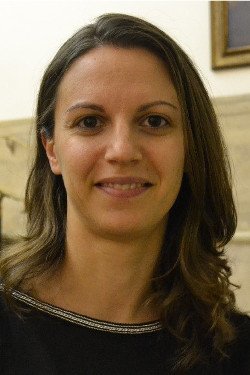Lucia Gualtieri
2018 Regional Award Finalist — Post-Doc

Current Position:
Postdoctoral Research Associate
Institution:
Princeton University
Discipline:
Geology & Geophysics

Current Position:
Postdoctoral Research Associate
Institution:
Princeton University
Discipline:
Geology & Geophysics
Recognized for: Contributions to the field of geophysics and seismology that have revolutionized our understanding of what globally detectable seismic background signals can tell scientists about environmental processes, such as hurricanes and landslides.
Areas of Research Interest and Expertise:
Interaction between atmosphere, ocean and solid Earth;
Physics of ambient seismic noise generation and noise source characteristics;
Seismic signals generated by rockfalls and landslides;
Seismic tomography and inverse problem theory;
Analytical and numerical modeling of seismic wave propagation.
Biography:
PhD, Institut de Physique du Globe de Paris, France & Università di Bologna, Italy
MS, Università di Bologna, Italy
BS, Università di Bologna, Italy
Only recently have geoscientists come to understand how ambient seismic noise is generated and propagated. Dr. Lucia Gualtieri is breaking new ground in the field of seismology and revolutionizing our scientific understanding of what seismic signals generated by events other than earthquakes – often called seismic noise – can tell scientists about events such as hurricanes and landslides. Utilizing rigorous theoretical and mathematical modeling techniques, Dr. Gualtieri has shown that seismic data can be used to probe time-dependent ocean and atmospheric activity and this information can be used to study the patterns of climate over time. In addition, Dr. Gualtieri has developed powerful seismological tools that can remotely analyze and track the properties of ‘mass wasting’ events, like rockfalls or landslides, in almost real time, and can reveal details of the interior structure of the earth.
"Using the background seismic signals generated by phenomena other than earthquakes is a unique way to understand the mutual interaction between the solid Earth and the other Earth systems, like the ocean and the atmosphere, and to study our planet as a whole. Despite the progress of the last decades, the potential of this novel research branch of seismology has just been expressed and exciting years lie ahead of us."
Key Publications:
Gualtieri, L., Camargo, J.S., Pascale, S., Pons, F.M.E., Ekström, G., 2018, The persistent signature of tropical cyclones in seismic ambient noise, Earth and Planetary Science Letters, 484, 287−294. https://www.sciencedirect.com/science/article/pii/S0012821X17307379
Gualtieri, L. and Ekström, G., 2018, Broadband analysis and modelling of the 2015 Taan Fjord, Alaska landslide using Instaseis, Geophysical Journal International, 213, 1912−1923 https://academic.oup.com/gji/article/213/3/1912/4923053
Gualtieri, L. and Ekström, G., 2017, Seismic reconstruction of the 2012 Palisades rockfall using the analytical solution to Lamb’s problem, Bulletin of the Seismological Society of America, 107(1), 63−71. https://pubs.geoscienceworld.org/bssa/article-lookup/107/1/63
Gualtieri, L., Stutzmann, E., Capdeville, Y., Ardhuin, F., Schimmel, M., Mangeney, A., Morelli, A., 2013. Modeling secondary microseismic noise by normal mode summation, Geophysical Journal International, 193(3), 1732−1745. https://academic.oup.com/gji/article/193/3/1732/613438
Other Honors:
2017 Keiiti Aki Young Scientist Award by the American Geophysical Union
2016 Laura Bassi Young Scientist Award by the Italian Physical Society
2014 Claudio Bonivento Scientific Research Award by the Università di Bologna
2012 Outstanding Student Presentation Award, received at 3rd International QUEST Workshop, Tatranska Lomnica, Slovakia
In the Media:
NOAA Climate Program Office - Seismic sensors record hurricane intensity, study finds.
NOAA Climate.gov - Seismic records may help answer if hurricanes have gotten stronger or more frequent.
Princeton University - Geophysicists and atmospheric scientists partner to track typhoons’ seismic footprints.
Independent - Scientists may have the explained the earth's mysterious 'hum'.